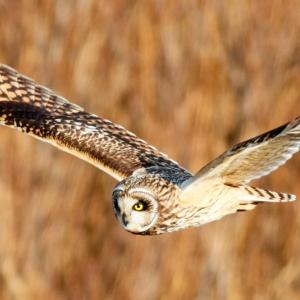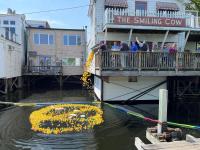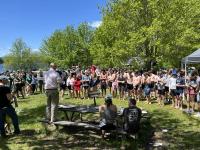Fifteen Years of Hoping Finally Pays Off
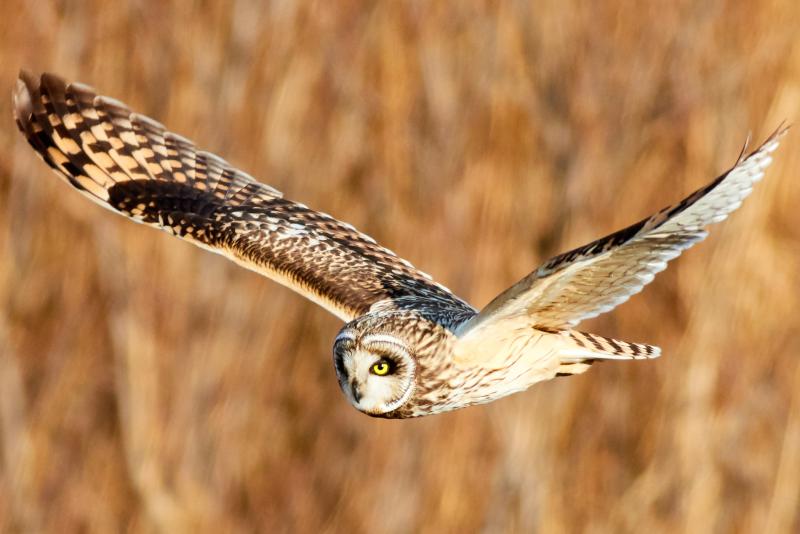 Short-eared owls migrate south to Maine from Canada, a few occasionally spending the winter and hunting at dusk in open grasslands, blueberry barrens, and marshes. Photo Jongsun Lee courtesy of Wikimedia Commons.
Short-eared owls migrate south to Maine from Canada, a few occasionally spending the winter and hunting at dusk in open grasslands, blueberry barrens, and marshes. Photo Jongsun Lee courtesy of Wikimedia Commons.
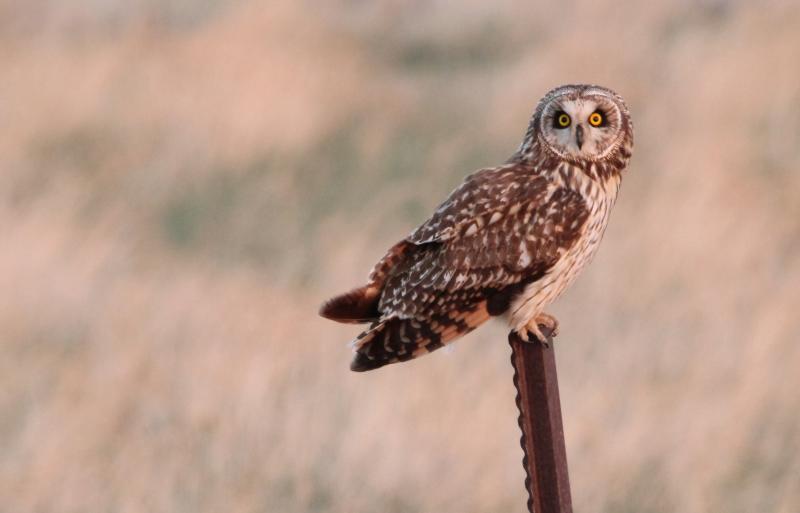 Don't look for ear tufts on the short-eared owl as the tufts are so small that they are not often visible. Photo Sandra Uecker\USFWS, courtesy Wikimedia Commons.
Don't look for ear tufts on the short-eared owl as the tufts are so small that they are not often visible. Photo Sandra Uecker\USFWS, courtesy Wikimedia Commons.
 Short-eared owls migrate south to Maine from Canada, a few occasionally spending the winter and hunting at dusk in open grasslands, blueberry barrens, and marshes. Photo Jongsun Lee courtesy of Wikimedia Commons.
Short-eared owls migrate south to Maine from Canada, a few occasionally spending the winter and hunting at dusk in open grasslands, blueberry barrens, and marshes. Photo Jongsun Lee courtesy of Wikimedia Commons.
 Don't look for ear tufts on the short-eared owl as the tufts are so small that they are not often visible. Photo Sandra Uecker\USFWS, courtesy Wikimedia Commons.
Don't look for ear tufts on the short-eared owl as the tufts are so small that they are not often visible. Photo Sandra Uecker\USFWS, courtesy Wikimedia Commons.
For more than 15 years we’ve been hoping.
We had said the phrase, “This is the perfect place for a short-eared owl,” so many times that it had become a kind of inside joke.
Birders know about this never-ending hope. Many of the places we visit regularly we think should be the place where some unusual bird will eventually pop up.
One of the places that we visit regularly (and that we’ve written about here before) is a patchwork of hayfields in Richmond. Depending on the season and the grandiosity of our dream birds, we’ve told ourselves that these grasslands should be the perfect place for: snowy owl, sedge wren, yellow rail, LeConte’s sparrow, Henslow’s sparrow, even northern lapwing. And, yes, short-eared owl.
Just last week, we cruised through the grasslands at dusk, scanning the fields with our binoculars and uttering those words again: “This is the perfect place for a short-eared owl.” Of course, we didn’t see anything.
But a few days later, we were scanning those fields again at dusk when suddenly there appeared in the fading light, against a gentle rise in the hayfield, the unmistakable buoyant flight and rounded head of a short-eared owl.
We couldn’t believe it!
Before long we lost sight of it and moved to another section of the field. It was almost too dark to see when we heard an odd, gentle barking sound in the distance. We scanned into the sky and were shocked to see not one but two short-eared owls circling around and calling while ascending higher into the sky. Eventually we lost sight them as it became too dark.
Short-eared owls are, unlike most owls of our region, birds of open country. They are one of the most widespread owl species in the world, occurring across North America, Eurasia, and parts of South America and Africa. In North America, they breed across Canada and Alaska south to the northern U.S. Maine has a handful of breeding records, but short-eared owls, are at best, very rare and infrequent breeding birds in the state.
Although short-eared owls are not seen frequently in the state, they do occur fairly regularly in migration and in winter. In some years a bird or two will stay long enough that many birders will have a chance to view them. Many birders have had the good fortune to see wintering short-eared owls in past years at Messalonskee Marsh in Belgrade and at the Brunswick Airport. We remember decades ago seeing at least one short-eared owl at the edge of the Augusta airport. Birding legend Peter Vickery found a wintering concentration of nine short-eared owls at another place in Richmond back in January of 1991. He continued seeing birds there into March of that year.
Wintering short-eared owls tagged in New York state were found to have originated from breeding grounds in northern Quebec and Labrador. We might expect birds visiting here in Maine to have come from this area, though we can’t be sure since there are limited tracking data available in the eastern part of their range.
The two short-eared owls we spotted have hung around for at least five days and have now been observed from along the roadside and at a safe distance (for the owls) by a number of other birders. A few other short-eared owls have been seen recently in other parts of the state. If you’ve ever said to yourself, “This looks like a good spot for a short-eared owl,” at some favorite birding spot, now is the time to go and check it!
Jeffrey V. Wells, Ph.D., is a Fellow of the Cornell Lab of Ornithology and Vice President of Boreal Conservation for National Audubon. Dr. Wells is one of the nation's leading bird experts and conservation biologists. He is a coauthor of the seminal “Birds of Maine” book and author of the “Birder’s Conservation Handbook.” His grandfather, the late John Chase, was a columnist for the Boothbay Register for many years. Allison Childs Wells, formerly of the Cornell Lab of Ornithology, is a senior director at the Natural Resources Council of Maine, a nonprofit membership organization working statewide to protect the nature of Maine. Both are widely published natural history writers and are the authors of the popular books, “Maine’s Favorite Birds” (Tilbury House) and “Birds of Aruba, Bonaire, and Curaçao: A Site and Field Guide,” (Cornell University Press).

